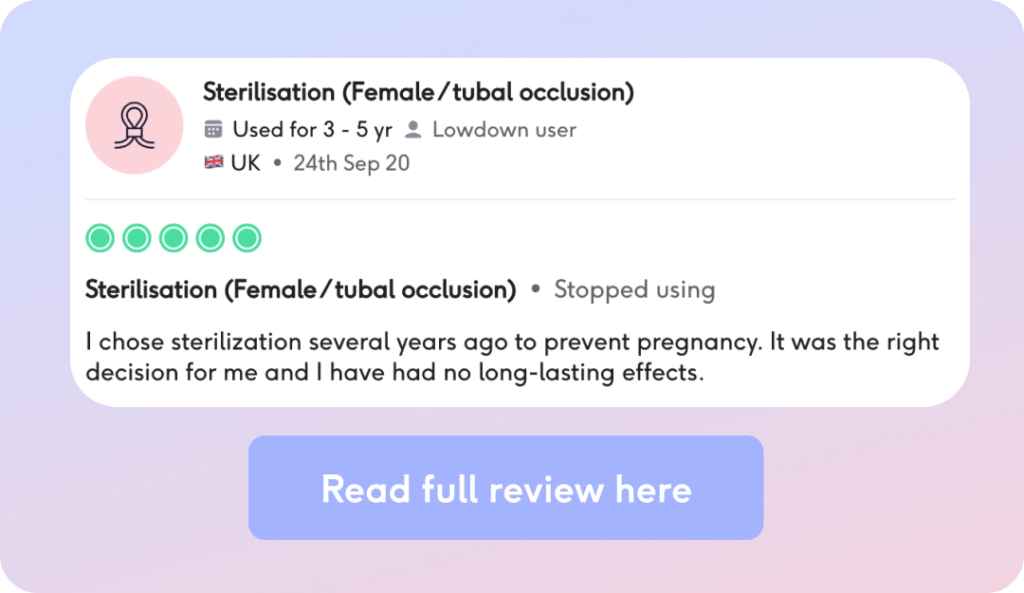Female sterilisation – fact vs fiction
Female sterilisation, which is also known as ‘having your tubes tied’, is a permanent surgical procedure to block or seal a woman’s fallopian tubes (which carry the egg from the ovaries to the womb). It works by preventing an egg from reaching the sperm. An egg will still be released each month, but it’ll be absorbed naturally into the body.
Female sterilisation can be done through the NHS or privately. The procedure involves the surgeon making a small cut near your belly button (laparoscopy) and inserting a long, thin instrument called a laparoscope that has a camera (to help the doctor see). The tubes are then blocked by applying clips or rings, or by tying, cutting or removing a small piece of the tube.
It’s important to know that sterilisation is incredibly difficult to reverse and for this reason other more effective contraceptive options should be thoroughly considered beforehand. (Yes that’s right – the implant and the hormonal coil are both more effective than female sterilisation at preventing pregnancy. Check out our page on contraceptive effectiveness explained to find out more). If you have a partner it’s important you discuss your options beforehand and ideally you should both agree to the procedure, however, since it is your body the final decision lies in your hands. The male vasectomy is also an option to consider. This may be preferred as it’s simpler, safer and cheaper. This form of contraception is also 99% effective and reversible.
Fiction: sterilisation causes cancer
It’s often thought that sterilisation for women can cause cancer in the reproductive organs (uterus, cervix and ovaries) but…
Fact:
Female sterilisation does not increase the risk of cancer. Little research has been done to investigate the relationship between breast cancer and female sterilisation, but there is absolutely no evidence to support this.
Fiction: only certain women can undergo sterilisation
Some women may avoid sterilisation as an option because they believe that only women of a certain age or that have a certain number of children can undergo female sterilisation.
Fact:
All women can have female sterilisation, no matter what age. However it should only be considered by women who do not want any more children or do not want children at all. Your GP may suggest you have counselling before coming to this decision and will want to be happy this decision is in your best interests.
Fiction: females no longer ovulate after sterilisation
It’s thought that female sterilisation prevents pregnancy either by stopping ovulation or by killing a woman’s egg.
Fact:
It does not in fact stop ovulation or harm a woman’s eggs. An egg will still be released each month, but will instead dissolve and be reabsorbed by the body (how clever!).
Fiction: women who have sterilisation lose their sex drive
People often think that this procedure will cause a loss of sex drive.
Fact:
After sterilisation nothing will change sexually in the female. The female will be able to have sex the same as before and may even find it more enjoyable as they don’t need to worry about pregnancy, condoms or other contraception. 67% of women who reviewed their sterilisation journey on The Lowdown stated they experienced no change in their sex drive.
Fiction: ALL of a woman’s reproductive organs will be removed in the operation
It would be false to think that female sterilisation involves the removal of some or all of a female’s reproductive organs – some people even think this includes removal of the vagina itself (ouch!)
Fact:
During the operation, the ovaries, uterus and cervix all remain in the same place as they were before. The only organs affected are the Fallopian tubes, which are blocked or cut.
Fiction: there are lots of health risks and side effects when undergoing female sterilisation
A common myth is that female sterilisation leads to major health risks or side effects, such as hysterectomy, poor health, pain and changes in menstrual bleeding or hormonal imbalances.
Fact:
There are no documented medical side effects after female sterilisation. The few surgical complications that do occur during or after sterilisation, such as a wound infection, can generally be kept to a minimum by good after care. Research has found no major changes in menstrual bleeding patterns after female sterilisation.

Whilst there are still a lot of myths surrounding female sterilisation and what the procedure actually involves, this effective but permanent method of contraception is actually quite popular with The Lowdown community. If you’ve undergone female sterilisation we’d love to hear from you!!
Our medical review process
This article has been medically reviewed for factual and up to date information by a Lowdown doctor.


